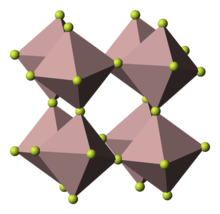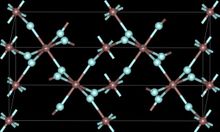فلوريد الحديد الثلاثي

| |

| |
| الأسماء | |
|---|---|
| أسماء أخرى
iron trifluoride, ferric fluoride
| |
| المُعرِّفات | |
| رقم CAS | |
3D model (JSmol)
|
|
| ChemSpider | |
| ECHA InfoCard | 100.029.093 |
PubChem CID
|
|
| رقم RTECS |
|
| UNII | |
CompTox Dashboard (EPA)
|
|
| |
| |
| الخصائص | |
| الصيغة الجزيئية | FeF3 |
| كتلة مولية | 112.840 g/mol (anhydrous) 166.89 g/mol (trihydrate) |
| المظهر | pale green crystals |
| الكثافة | 3.87 g/cm3 (anhydrous) 2.3 g/cm3 (trihydrate) |
| نقطة الانصهار | |
| قابلية الذوبان في الماء | slightly soluble (anhydrous) 49.5 g/100 mL (trihydrate) |
| قابلية الذوبان | negligible in alcohol, ether, benzene |
| القابلية المغناطيسية | +13,760·10−6 cm3/mol |
| البنية | |
| البنية البلورية | Rhombohedral, hR24 |
| الزمرة الفراغية | R-3c, No. 167 |
| المخاطر | |
| خطر رئيسي | Corrosive |
| صفحة بيانات السلامة | External SDS |
| ن.م.ع. مخطط تصويري |   [1] [1]
|
| ن.م.ع. كلمة الاشارة | Danger[1] |
| H302, H312, H314, H332[1] | |
| P260, P301+P330+P331, P303+P361+P353, P305+P351+P338, P405, P501[1] | |
| مركبات ذا علاقة | |
أنيونات أخرى
|
Iron(III) oxide, Iron(III) chloride |
كاتيونات أخرى
|
Manganese(III) fluoride, Cobalt(III) fluoride, Ruthenium(III) fluoride |
مركـّبات ذات علاقة
|
Iron(II) fluoride |
ما لم يُذكر غير ذلك، البيانات المعطاة للمواد في حالاتهم العيارية (عند 25 °س [77 °ف]، 100 kPa). | |
| مراجع الجدول | |
فلوريد الحديد الثلاثي Iron(III) fluoride، ويُعرف أيضاً بإسم فلوريد الحديديك ferric fluoride، هي مركبات غير عضوية صيغتها FeF3(H2O)x حيث x = 0 or 3. They are mainly of interest by researchers, unlike the related iron(III) chloride. Anhydrous iron(III) fluoride is white, whereas the hydrated forms are light pink.[2]
الخصائص الكيميائية والطبيعية
Iron(III) fluoride is a thermally robust, antiferromagnetic[3] solid consisting of high spin Fe(III) centers, which is consistent with the pale colors of all forms of this material. Both anhydrous iron(III) fluoride as well as its hydrates are hygroscopic.
البنية
The anhydrous form adopts a simple structure with octahedral Fe(III)F6 centres interconnected by linear Fe-F-Fe linkages. In the language of crystallography, the crystals are classified as rhombohedral with an R-3c space group.[4] The structural motif is similar to that seen in ReO3. Although the solid is nonvolatile, it evaporates at high temperatures, the gas at 987 °C consists of FeF3, a planar molecule of D3h symmetry with three equal Fe-F bonds, each of length 176.3 pm.[5] At very high temperatures, it decomposes to give FeF2 and F2.[4]
Two crystalline forms—or more technically, polymorphs—of FeF3·3H2O are known, the α and β forms. These are prepared by evaporation of an HF solution containing Fe3+ at room temperature (α form) and above 50 °C (β form). The space group of the β form is P4/m, and the α form maintains a P4/m space group with a J6 substructure. The solid α form is unstable and converts to the β form within days. The two forms are distinguished by their difference in quadrupole splitting from their Mössbauer spectra.[6]
التحضير والتواجد والتفاعلات
Anhydrous iron(III) fluoride is prepared by treating virtually any anhydrous iron compound with fluorine. More practically and like most metal fluorides, it is prepared by treating the corresponding chloride with hydrogen fluoride:[7]
- FeCl3 + 3 HF → FeF3 + 3 HCl
It also forms as a passivating film upon contact between iron (and steel) and hydrogen fluoride.[8] The hydrates crystallize from aqueous hydrofluoric acid.[6]
The material is a fluoride acceptor. With xenon hexafluoride it forms [FeF4][XeF5].[4]
Pure FeF3 is not yet known among minerals. However, hydrated form is known as the very rare fumarolic mineral topsøeite. Generally a trihydrate, its chemistry is slightly more complex: FeF[F0.5(H2O)0.5]4·H2O.[9][10]
التطبيقات
The primary commercial use of iron(III) fluoride in the production of ceramics.[11]
Some cross coupling reaction are catalyzed by ferric fluoride-based compounds. Specifically the coupling of biaryl compounds are catalyzed by hydrated iron(II) fluoride complexes of N-heterocyclic carbene ligands. Other metal fluorides also catalyse similar reactions.[12][13] Iron(III) fluoride has also been shown to catalyze chemoselective addition of cyanide to aldehydes to give the cyanohydrins.[14]
السلامة
The anhydrous material is a powerful dehydrating agent. The formation of ferric fluoride may have been responsible for the explosion of a cylinder of hydrogen fluoride gas.[15]
المراجع
- ^ أ ب ت ث "Iron(III) Fluoride". American Elements. Retrieved November 5, 2018.
- ^ Housecroft, Catherine E.; Sharpe, Alan G. (2008) Inorganic Chemistry (3rd ed.), Pearson: Prentice Hall. ISBN 978-0-13-175553-6.
- ^ Wollan, E. O.; Child, H. R.; Koehler, W. C.; Wilkinson. M. K. (November 1958). "Antiferromagnetic properties of the iron group trifluorides". Physical Review. 112 (4): 1132–1136. Bibcode:1958PhRv..112.1132W. doi:10.1103/PhysRev.112.1132.
- ^ أ ب ت Greenwood, N. N. (1997). Chemistry of the Elements (2nd Edition ed.). Oxford:Butterworth-Heinemann. ISBN 0-7506-3365-4.
{{cite book}}:|edition=has extra text (help); Unknown parameter|coauthors=ignored (|author=suggested) (help) - ^ Hargittai, M.; Kolonits, M.; Tremmel, J.; Fourquet. J.; Ferey, G. (January 1990). "The molecular geometry of iron trifluoride from electron diffraction and a reinvestigation of aluminum trifluoride". Structural Chemistry. 1 (1): 75–78. doi:10.1007/BF00675786. S2CID 96178006.
- ^ أ ب Karraker, D. G.; Smith, P. K. (March 1992). "α- and β-FeF3•3H2O Revisited: Crystal Structure and 57Fe Mössbauer Spectra". Inorganic Chemistry. 31 (6): 1118–1120. doi:10.1021/ic00032a042.
- ^ Handbook of Preparative Inorganic Chemistry, 2nd Ed. Edited by G. Brauer, Academic Press, 1963, NY. Vol. 1. p. 266-7.
- ^ J. Aigueperse, P. Mollard, D. Devilliers, M. Chemla, R. Faron, R. Romano, J. P. Cuer, "Fluorine Compounds, Inorganic" in Ullmann's Encyclopedia of Industrial Chemistry, Wiley-VCH, Weinheim, 2005.DOI:10.1002/14356007.a11_307
- ^ "Topsøeite".
- ^ "List of Minerals". 21 March 2011.
- ^ "Ferric Fluoride." CAMEO Chemicals. National Oceanic and Atmospheric Administration. Web. 7 Apr. 2010. <http://cameochemicals.noaa.gov/chemical/3468>
- ^ Hatakeyama, T.; Nakamura M. (July 2007). "Iron-Catalyzed Selective Biaryl Coupling: Remarkable Suppression of Homocoupling by the Fluoride Anion". Journal of the American Chemical Society. 129 (32): 9844–9845. doi:10.1021/ja073084l. PMID 17658810.
- ^ Hatakeyama, T.; Hashimoto, S.; Ishizuka, K.; Nakamura, M. (July 2009). "Highly Selective Biaryl Cross-Coupling Reactions between Aryl Halides and Aryl Grignard Reagents: A New Catalyst Combination of N-Heterocyclic Carbenes and Iron, Cobalt, and Nickel Fluorides". Journal of the American Chemical Society. 131 (33): 9844–9845. doi:10.1021/ja9039289. PMID 19639999.
- ^ Bandgar, B. T.; Kamble, V. T. (July 2001). "Organic Reactions in aqueous medium: FeF3 catalyzed chemoselective addition of cyanotrimethylsilane to aldehydes". Green Chemistry. 3 (5): 265. doi:10.1039/b106872p.
- ^ "A recent explosion of a lecture-size cylinder of hydrogen fluoride ... has renewed concerns that compressed gas cylinders can be especially dangerous" (PDF). University of California San Francisco. Archived from the original (PDF) on 2006-09-01.